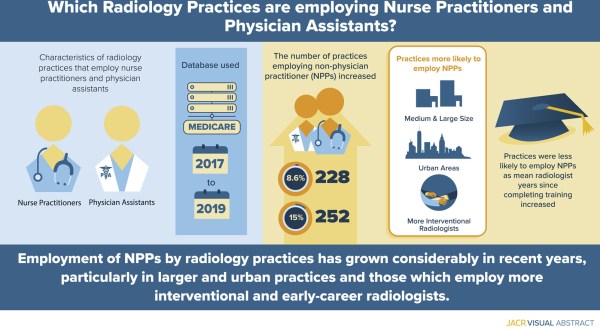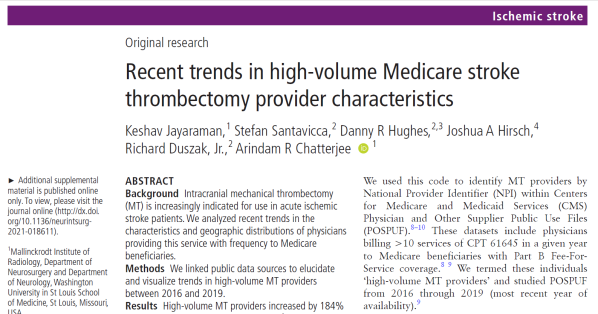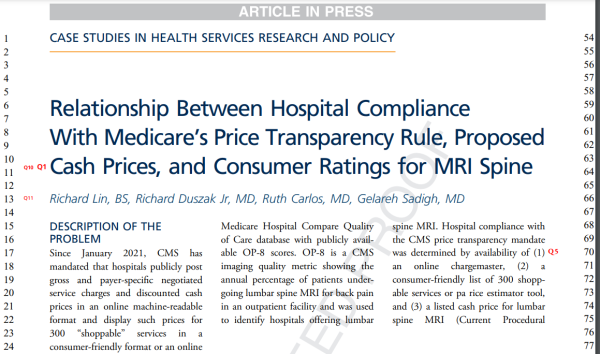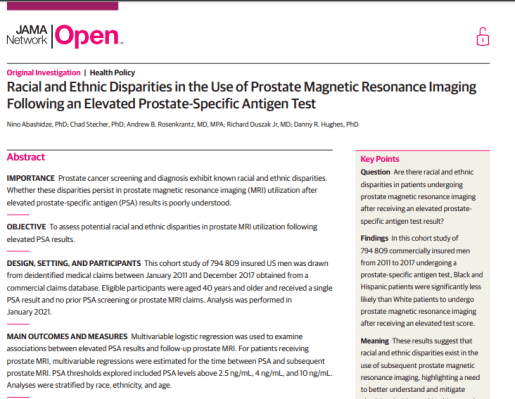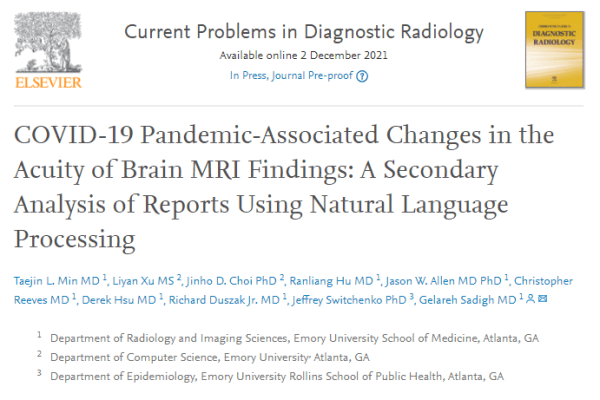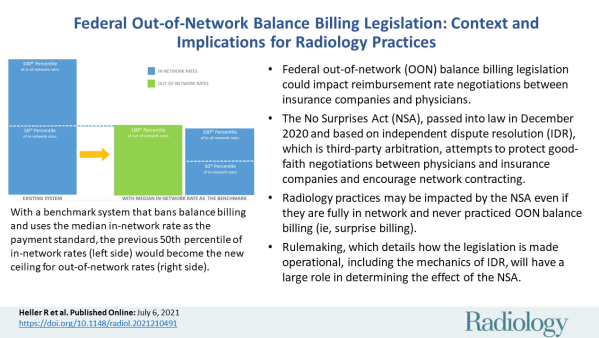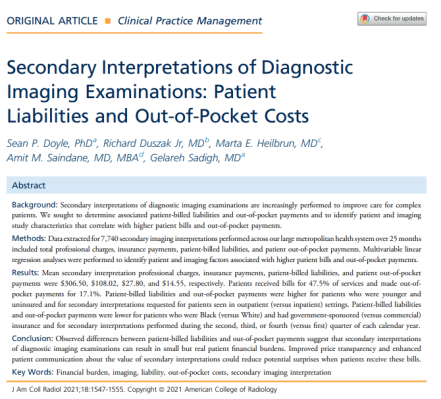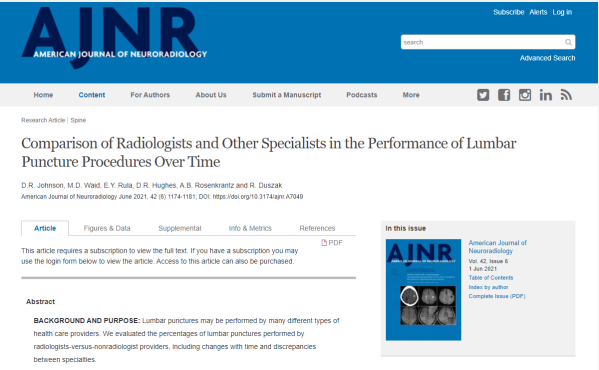March 4, 2022
The number and roles of US nonphysician practitioners (NPPs) have expanded considerably, but little is known about their use by radiology practices. The authors assessed characteristics and trends of radiology practices employing Medicare-recognized NPPs.
Intracranial mechanical thrombectomy (MT) is increasingly indicated for use in acute ischemic stroke patients. The researchers analyzed recent trends in the characteristics and geographic distributions of physicians providing this service with frequency to Medicare beneficiaries. Full Article
Keshav Jayaraman, Stefan Santavicca, Danny R Hughes, Joshua A Hirsch, Richard Duszak, Jr., Arindam R Chatterjee. 2022. "Recent Trends in High-volume Medicare Stroke Thrombectomy Provider Characteristics," Journal of NeuroInterventional Surgery
Between September and October 2021, the researchers manually searched the websites of all hospitals listed in the Medicare Hospital Compare Quality of Care database with publicly available OP-8 scores. OP-8 is a CMS imaging quality metric showing the annual percentage of patients undergoing lumbar spine MRI for back pain in an outpatient facility and was used to identify hospitals offering lumbar spine MRI. Hospital compliance with the CMS price transparency mandate was determined by a multivariable model. Read the study for full details. Full Article
Richard Lin, BS, Richard Duszak Jr., MD, Ruth Carlos, MD, Gelareh Sadigh, MD. 2022. "Relationship Between Hospital Compliance With Medicare’s Price Transparency Rule, Proposed Cash Prices, and Consumer Ratings for MRI Spine," Journal of American College of Radiology (JACR)
In this cohort study of 794,809 commercially insured men from 2011 to 2017 undergoing a prostate-specific antigen test, Black and Hispanic patients were significantly less likely than White patients to undergo
prostate magnetic resonance imaging after receiving an elevated test score. Full Article
Nino Abashidze, PhD, Chad Stecher, PhD, Andrew B. Rosenkrantz, MD, MPA, Richard Duszak Jr, MD, Danny R. Hughes, PhD. 2021. "Racial and Ethnic Disparities in the Use of Prostate Magnetic Resonance Imaging Following an Elevated Prostate-Specific Antigen Test," JAMA Network Open
We aimed to assess early COVID-19 pandemic-associated changes in brain MRI examination frequency and acuity of imaging findings acuity. Full Article
Taejin L. Min, MD, Liyan Xu, MS,Jinho D.Choi, PhD, Ranliang Hu, MD, Jason W.Allen, MD,PhD, Christopher Reeves, MD, Derek Hsu,MD, Richard Duszak Jr.,MD, Jeffrey Switchenko, PhD, Gelareh Sadigh, MD. 2021. "COVID-19 Pandemic-Associated Changes in the Acuity of Brain MRI Findings: A Secondary Analysis of Reports Using Natural Language Processing," Current Problems in Diagnostic Radiology
November 22, 2021
To facilitate this engagement, the ACR offers several current opportunities for ACR members to apply for research grants through two research centers at the College: the ACR Center for Research and Innovation™ (CRI) and the Harvey L. Neiman Health Policy Institute® (NHPI). These funding opportunities will facilitate future practice innovations through research and education for the Read More
September 1, 2021
New ACR funds will provide members with the opportunities to make meaningful contributions to research that advance the College’s mission. Read the September ACR Bulletin Research Rounds column.
Because of its effect on reimbursement rate negotiations between insurance companies and physicians, the No Surprises Act legislation regarding out-of-network balance billing (ie, surprise billing) could have substantial financial and operational impacts on radiology and other hospital-based specialties. Full Article
Richard Heller, MD, Ed Gaines, MD, Naveen Parti, MD, Richard Duszak, MD. 2021. "Federal Out-of-Network Balance Billing Legislation: Context and Implications for Radiology Practices," Radiology
Secondary interpretations of diagnostic imaging examinations are increasingly performed to improve care for complex patients. This study sought to determine associated patient-billed liabilities and out-of-pocket payments and to identify patient and imaging study characteristics that correlate with higher patient bills and out-of-pocket payments. Full Article
Sean P. Doyle, MD, Richard Duszak Jr, MD, Marta E. Heilbrun, MD, Amit M. Saindane, MD, MBA, Gelareh Sadigh, MD. 2021. "Secondary Interpretations of Diagnostic Imaging Examinations: Patient Liabilities and Out-of-Pocket Costs," Journal of American College of Radiology (JACR)
Lumbar punctures may be performed by many different types of health care providers. This study evaluates the percentages of lumbar punctures performed by radiologists-versus-nonradiologist providers, including changes with time and discrepancies between specialties. Full Article
D.R. Johnson, MD, Mikki Waid, PhD, Danny R. Hughes, PhD, Andrew B. Rosenkrantz, MD, Richard Duszak, MD. 2021. "Comparison of Radiologists and Other Specialists in the Performance of Lumbar Puncture Procedures Over Time," American Journal of Neuroradiology

